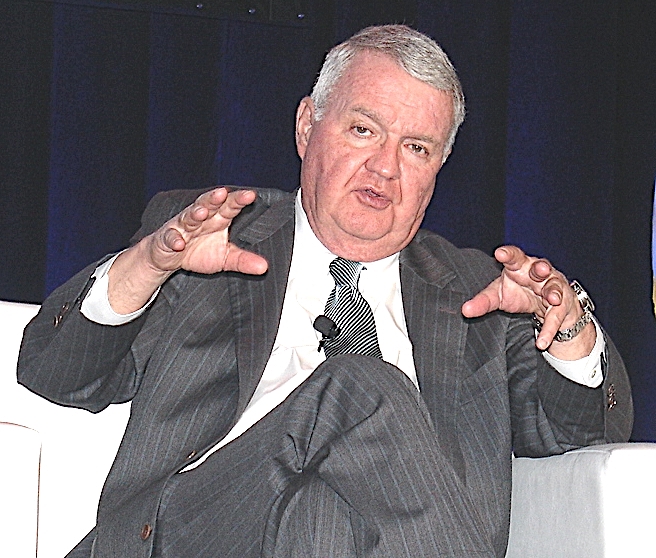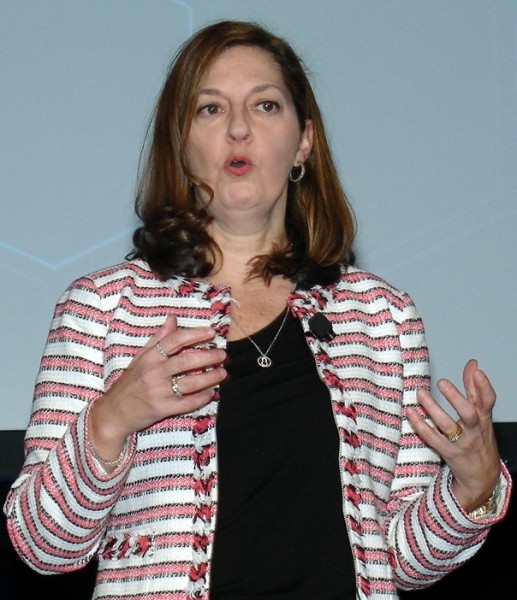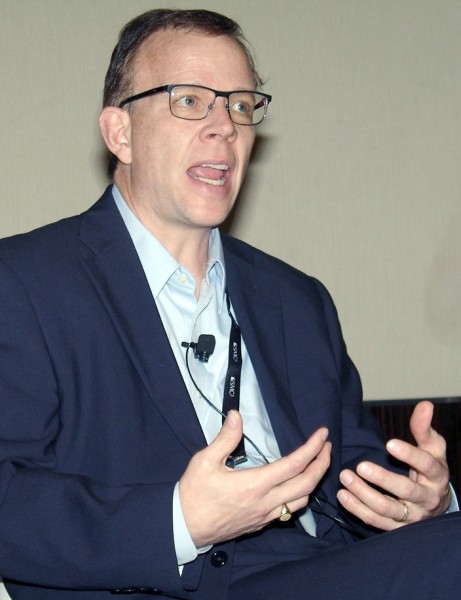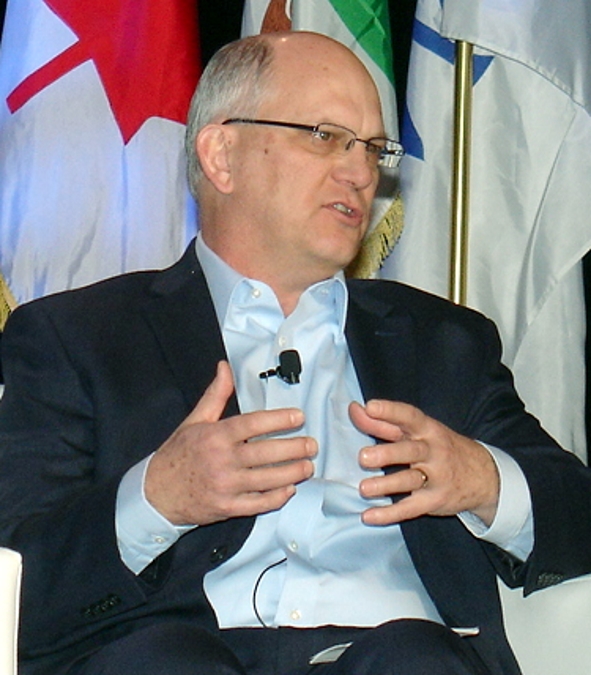The customer-centric approach championed by Amazon is guiding the e-commerce giant’s governmental policies – and is at the foundation of logistics industry decisions in an increasingly technology-oriented environment.
Those views and more – including projections of record-high freight rates – were among thoughts expressed as SMC3 presented Jump Start ’18 in Atlanta Jan. 22-24.
“Customer obsession is informing how we look at policy,” Amazon’s director of transportation public policy, Blair Anderson, told AJOT after speaking on the conference’s final day. “Being customer-obsessed is ingrained in our culture.”

Anderson, who served as undersecretary of transportation under President Obama, said Amazon’s priorities in Washington include advancement of a comprehensive infrastructure bill, impetus for which has been provided by December’s passage of a sweeping U.S. tax system overhaul.
“There are a lot of challenges,” Anderson said, “but, with the passage of tax reform, there’s an awful lot of renewed energy about getting infrastructure done.”
Citing President Trump’s long-expressed interest in upgrading American infrastructure, Anderson said he was anticipating White House release of its plan about a week after Trump’s Jan. 30 State of the Union address, adding that how to pay for a program that could cost as much as $1 trillion is “always the biggest question.”
Although a higher federal gas tax is “probably off the table,” according to Anderson, consideration is still being given to such potential funding mechanisms as a vehicle miles traveled, or VMT, levy and tolling on new and/or existing highways.
James H. Burnley IV, who served as the nation’s secretary of transportation in the Reagan administration and who currently is a partner in the Washington-based Venable LLP law firm, told Jump Start attendees that savings gleaned by transportation companies as a result of tax reform may well be reinvested in business and hence “kick up” merger and acquisition activity in the sector.

Randy Mullett, former vice president of government relations for less-than-truckload transport provider Con-way Inc. (acquired in 2015 by XPO Logistics) and current principal of Mullett Strategies LLC, said he sees freed-up cash facilitating driver pay hikes, as well as spurring a “huge flurry” starting later this year of mergers and acquisitions in the transportation space.
This year also could see freight rates escalating toward record levels, according to Benjamin Hartford, senior research analyst for transportation at Robert W. Baird & Co.
Noting that freight rates already have fallen into a cyclical trough and available capacity continues to tighten, Hartford commented, “Incorporating late December’s ELD (truck electronic-logging device) mandate implementation and rising business and consumer confidence lays the foundation for accelerating pricing across all modes in 2018 and likely through the end of the decade.”
Another economist, Dr. Donald Ratajczak of Georgia State University, said he perceives a recession by early 2020, but, he said, e-business will continue to lead the way in commerce while traditional retail store locations will continue to close at the rate of thousands per year. Ratajczak said e-commerce, now representing only 11 percent of total U.S. retail sales, should account for 50 percent of remaining sales growth, exclusive of passenger vehicles and building materials.
James Welch, chief executive officer of Overland Park, Kansas-based trucking holding company YRC Worldwide Inc., said he believes e-commerce provides significant opportunities for less-than-truckload businesses, including his, particularly as online retailers pursue lowest-cost shipping options in a world in which consumers have come to expect free shipping.
On the topic of business consolidations, Welch, whose company dates to the 2003 Yellow-Roadway merger, said he does not see further M&A activity in YRC’s future, and Jason Hess, vice president and general manager of premium business at Union Pacific Railroad, said he believes it would be “challenging” for there to be additional M&A action in the rail industry.
Whereas e-commerce is clearly on the rise, brick-and-mortar stores aren’t losing their place, according to Sarah Galica, senior director of reverse logistics at The Home Depot, the largest U.S. home improvement retailer, headquartered in suburban Atlanta.

“One thing we have as our advantage is more than 2,000 retail stores where customers can return items,” Galica said, noting that returns to stores also include online purchases. “A lot of times, bringing something back to the store is the most convenient.”
Tony Sciarrotta, executive director of The Reverse Logistics Association, said that, with the return rate of e-commerce purchases being three to four times higher than that for brick-and-mortar buys, and with consumers demanding free returns, reverse logistics will be a sustained growth sector.
Greg Smith, a former IBM and Oracle executive who serves as enterprise consultant with the Tech Mahindra software firm, underscored the increasing importance of positioning goods closer to consumers while leveraging data to furnish flexible and personalized services.
“Customer experience is the differentiator in the supply chain,” Smith said. “You must constantly be offering better value to customers.”
Adrian Gonzalez, president of Adelante SCM, a Newton, Massachusetts-based supply chain research and consulting firm, said successful companies will be those viewing logistics not as a cost center but rather as a competitive weapon, “putting the customer at the center of the supply chain universe.”
“The challenge, as always,” he said, “is how do you find the perfect balance between time, cost and quality – and do it profitably.”
Gonzalez characterized last-mile delivery as “the new battleground,” with both Walmart and Target having made recent acquisitions in that regard, while, he said, technological advances – from driverless trucks to drones to “hyperloop” high-speed magnetic tubes – are increasingly changing how goods are shipped. Also, what is being shipped is shifting, with Gonzalez advancing a “potential vision” of extensive shipments of computer-aided design, or CAD, files for 3-D printing to homes where 3-D printers have become as common as televisions.
Nonetheless, Gonzalez said, as companies aim to be neither too early nor too late to engage in new technologies, the human element remains paramount. He commented, “This industry still is about relationships and trust.”
During the conference, three trusted collaborations in particular were singled out for award recognition: Tire manufacturer Michelin’s partnership with visibility provider FourKites and motor carrier Averitt Express, furnishing real-time tracking for less-than-truckload shipments; the teaming of Frios Gourmet Pops with Cold Box and Averitt Express on shipping frozen treats throughout the country from the Frios plant in Alabama; and logistical networking of Wayne Farms’ poultry plants by C.H. Robinson and R.E. Garrison Trucking.
Finding the right trusted partner for the long term was cited as well in a conference session featuring logistics leaders of North Olmstead, Ohio-based Moen, North America’s top faucet brand, in which Alan Loos, Moen’s senior manager for order fulfillment systems, said, “We believe in relationships, not transactions.”
Loos and Michael Leaser, Moen’s director of global logistics and transportation, said they are happy with the firm’s choice, at the culmination of a three-year evaluation and selection process, of MercuryGate to provide a technology platform to deliver the fast-growing company from its former paperwork-intensive manual system for handling shipments.

Leaser said the MercuryGate solution is providing enhanced visibility that supports better planning of freight moves, including backhauls, but, he said, many companies still seem to overlook the importance of an efficient supply chain, commenting, “Logistics is a necessary evil, so people don’t give it the time and mindshare that it deserves.”
Shipment visibility also was identified as a critical element for Denver-based Ardent Mills, North America’s largest flour miller, with the company’s senior director of transportation and logistics, Dave Venberg, saying real-time visibility is proving vital in driving inefficiencies out of its supply chain.

Whereas technology facilitates improvements, Venberg mused about it bringing about concerns as well, asking rhetorically, “What are we going to do when we have 3-D food printing?”
For Jump Start reception photos, please see the February 26 edition of AJOT.


_-_28de80_-_d88095865f9f1cbb4ecdd37edf61c63efd603428_lqip.png)

